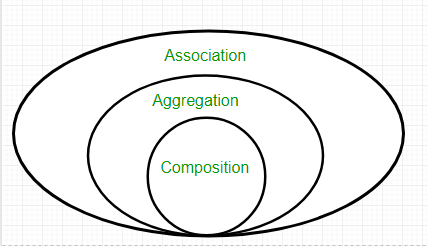Composition in Java
Last Updated :
26 Apr, 2022
The composition is a design technique in java to implement a has-a relationship. Java Inheritance is used for code reuse purposes and the same we can do by using composition. The composition is achieved by using an instance variable that refers to other objects. If an object contains the other object and the contained object cannot exist without the existence of that object, then it is called composition. In more specific words composition is a way of describing reference between two or more classes using instance variable and an instance should be created before it is used.

The benefits of using Composition is as follows:
- Composition allows the reuse of code.
- Java doesn’t support multiple inheritances but by using composition we can achieve it.
- Composition offers better test-ability of a class.
- By using composition, we are flexible enough to replace the implementation of a composed class with a better and improved version.
- By using composition, we can also change the member objects at run time, to dynamically change the behaviour of your program.
Do remember the certain key points of composition in java which are as follows:
- It represents a has-a relationship.
- In composition, both entities are dependent on each other.
- When there is a composition between two entities, the composed object cannot exist without the other entity. For example, A library can have no. of books on the same or different subjects. So, If the Library gets destroyed then All books within that particular library will be destroyed. This is because books can not exist without a library.
- The composition is achieved by using an instance variable that refers to other objects.
- We have to favour Composition over Inheritance.
Now let us finally refer to the below image in order to get a faint hint about the aggregation and to better understand how the composition works, let us take an example of the real-time library system.
Real-life Example: Library system
Let’s understand the composition in Java with the example of books and library. In this example, we create a class Book that contains data members like author, and title and create another class Library that has a reference to refer to the list of books. A library can have no. of books on the same or different subjects. So, If the Library gets destroyed then All books within that particular library will be destroyed. i.e., books can not exist without a library. The relationship between the library and books is composition.
Implementation:
Example
Java
import java.io.*;
import java.util.*;
class Book {
public String title;
public String author;
Book(String title, String author)
{
this.title = title;
this.author = author;
}
}
class Library {
private final List<Book> books;
Library(List<Book> books)
{
this.books = books;
}
public List<Book> getListOfBooksInLibrary()
{
return books;
}
}
class GFG {
public static void main(String[] args)
{
Book b1
= new Book("EffectiveJ Java", "Joshua Bloch");
Book b2
= new Book("Thinking in Java", "Bruce Eckel");
Book b3 = new Book("Java: The Complete Reference",
"Herbert Schildt");
List<Book> book = new ArrayList<Book>();
book.add(b1);
book.add(b2);
book.add(b3);
Library library = new Library(book);
List<Book> books
= library.getListOfBooksInLibrary();
for (Book bk : books) {
System.out.println("Title : " + bk.title
+ " and "
+ " Author : " + bk.author);
}
}
}
|
Output
Title : EffectiveJ Java and Author : Joshua Bloch
Title : Thinking in Java and Author : Bruce Eckel
Title : Java: The Complete Reference and Author : Herbert Schildt
Share your thoughts in the comments
Please Login to comment...